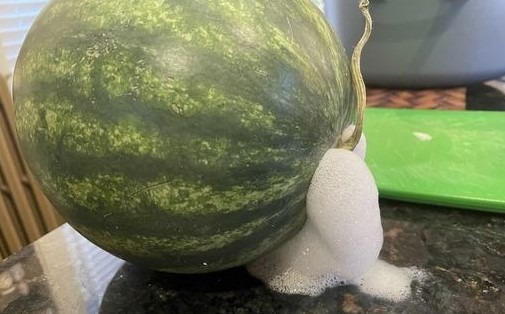Recently, while browsing social media, I came across a post that was both surprising and concerning. The post showed a picture of a watermelon sitting on a kitchen counter with foam oozing out of a crack in its skin. The accompanying message was alarming: “We bought this watermelon from Costco, and after setting it on the counter, it started foaming.” The person who posted it, Barbara, quickly did some research and discovered that foaming watermelons could explode due to fermentation. Acting fast, they carefully placed the foaming watermelon in a plastic bag and took it outside. The next morning, they found that the watermelon had exploded, leaving a mess of maggots and a hole in their trash can.
As someone who enjoys watermelon regularly, this story caught my attention and made me think twice about my favorite summer fruit.
Why Do Watermelons Explode?
Watermelons can sometimes foam and burst when they start to spoil, especially if they’ve been left in hot conditions. When bacteria invade the fruit, they break down the sugars and release carbon dioxide gas. As the gas builds up inside the watermelon, pressure increases. If the pressure becomes too great, the watermelon can explode, much like a pressurized container.
What to Do If Your Watermelon Is Foaming
If you notice your watermelon foaming, it’s a clear sign that it’s fermenting and may be unsafe to eat. Here’s what you should do:
- Don’t eat it: A foaming watermelon is likely spoiled and could make you sick if consumed.
- Handle with care: Gently move the watermelon to an area where it can be easily disposed of. It’s best to place it in a plastic bag to contain any mess.
- Dispose of it immediately: Take the watermelon outside and place it in an outdoor trash can, away from your home, to prevent it from bursting indoors.
How to Prevent Watermelon Explosions
While it’s rare for watermelons to explode, it’s better to be safe than sorry. Here are some tips to prevent this from happening:
- Inspect before buying: Choose watermelons that are firm, evenly shaped, and free of bruises or blemishes. Avoid those with black spots, cuts, or soft areas.
- Store properly: Keep your watermelon in a cool, dry place. Refrigeration is ideal, as it slows down the spoilage process.
- Consume quickly: Eat your watermelon soon after purchasing it to avoid fermentation.
- Handle with care: Be gentle with your watermelon to prevent any cracks that could allow bacteria to enter.
Conclusion
After seeing that post, I immediately checked the watermelon I had recently bought. Thankfully, it was in perfect condition—firm, intact, and odor-free. However, the story has made me more cautious. Now, I pay extra attention to my watermelons, ensuring they are stored correctly and consumed in a timely manner. The next time you buy a watermelon, take a moment to inspect it carefully and store it properly when you get home. And if you notice any signs of foaming, you know what to do—remove it immediately!
Remember, a foaming watermelon is not something to ignore. By taking the right precautions, you can avoid the unpleasant experience of dealing with an exploding fruit. Stay safe and enjoy your watermelon!


 Flip it!
Flip it!





